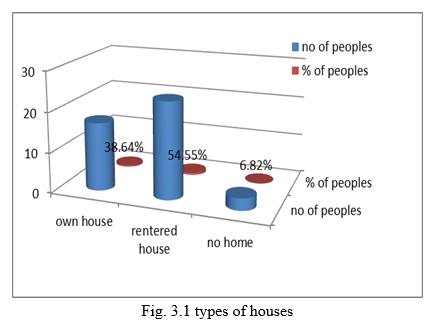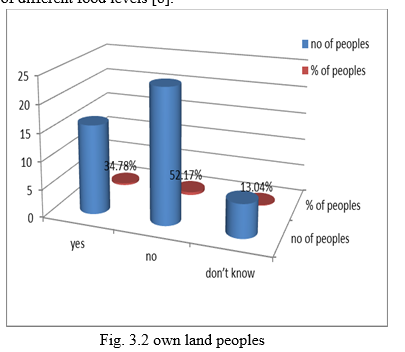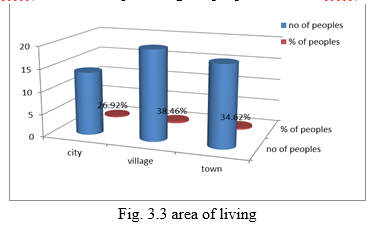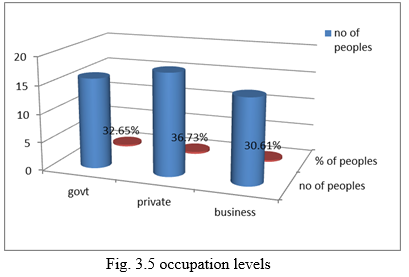Ijraset Journal For Research in Applied Science and Engineering Technology
- Home / Ijraset
- On This Page
- Abstract
- Introduction
- Conclusion
- References
- Copyright
Importance of Social Status Influence on Community Development in Pedagantyada Village of Visakhapatnam District
Authors: Dr. Ch. Asha Kiran Raju, Prof. T. Sobha Sri
DOI Link: https://doi.org/10.22214/ijraset.2022.42917
Certificate: View Certificate
Abstract
Throughout the beyond a decade or something to that effect, the possibility of social capital has filled in importance in a grouping of related fields of study, including the unmistakable verification of components influencing educational achievement, explanations of changing levels of interest in formal and relaxed adult preparation, and conditions expected for the turn of events and improvement of foundations and practices accommodating for dependable learning. Inside these particular circumstances, social status has been described in various ways, all of which have been associated with total norms, values, and associations reflecting human individuals\' help in \"a commonplace life considering family and neighborhood.\" such way, social capital improvement appears to have direct associations with neighborhood guidance, since neighborhood is completely portrayed as a social learning process that empowers individuals and remember them as inhabitants for total activities zeroed in on monetary development. In this responsibility, the maker raises uncertainty about the authenticity and sufficiency of social capital as a keen thought in adult tutoring research by plunging into different central matters of interest concerning the normal associations between neighborhood and social capital redesign. The data was analyzed using ANOVA and multivariate techniques. We recognize maternal prosperity factors in natural ways of life, as well as the purposes behind clinical issues and chance components for people. An audit is being driven in Pedagantyada in the Visakhapatnam district as an element of the continuous survey.
Introduction
I. INTRODUCTION
Neighbourhood is a headway framework that bright lights on people's total undertakings to work on their regular surroundings while relying upon their own drive and movement whatever amount as could sensibly be anticipated [1]. Regardless, the possibility of "neighborhood" used in personal development headway is a wobbly one that has been used in a variety of investigation settings. At the methodology level, there has been a tendency to portray "the neighborhood," without demonstrating whether it insinuates a spatial or party [2]. As a matter of fact, social class is as frequently as conceivable contained a knot of gatherings and vested parties that are routinely gotten in genuine associations [3]. Anyway inhabitants of lamentable organizations could share specific unmistakable properties (for example, low and flighty compensation, intermittent work, limited induction to structure organizations, and a generally awful personal satisfaction), the families are quantifiably specific in each other's eyes [4]. These family credits shape their attitudes toward neighborhood amicable action in portraying and settling ordinary issues [5-6].
- Aim: The aim of the present study was to highlight the socio-economic transition along with lifestyle modifications which result in urgent health problems in majority of tribal groups.
- Methodology: The present study is a compilation of various studied tribal population of India by research scientists. By comparing the tribes from different geographic region and find out the reason of poverty and under nutrition among them even after providing support and funds from government and other organizations was incorporated.
II. RESEARCH METHODOLOGY
A. Statement of the problem
The statement of the problem is “A study on impact of Factors influencing Community Development with respect to Social status”.
B. Objectives of the study
- To know the societal position of Community Development
- To realize the societal position levels of Community people groups concerning their economy.
- To realize the Community people groups different societal position levels like their home sorts, own properties like land, houses and so forth and people groups residing region like city and town.
C. Hypotheses of the Study
- There will be no huge contrast between societal position levels of Community people groups
- There will be no tremendous distinction among the living in city and town and their societal position of Community people groups.
- There will be no tremendous distinction between kinds of work/occupation like government, private and business for economic wellbeing levels in Community.
D. Significance of the Study
The appropriate examination of Community Development as for societal position levels is essential and significant. While choosing Community for economic wellbeing levels to observe the various elements like their homes types, own properties and their residing region and family foundation and their occupation levels. The target in each Community Development unit ought to be the arrangement of the ideal guide with flawless timing.
E. Sample of the Study
The populace situated in Community that has been plainly characterized and a rundown of all the Community for the better society economic wellbeing reason for choice is prepared. Different Community Development societal position factors taken are around of equivalent levels. Factors are autonomous of one another and the determination is impartial. Each economic well-being factors are available variable once chosen was not forgotten about or supplanted by different elements.
F. Variables Studied
While choosing the example for this study the examiner considered the Variables like houses types, own properties and their residing region and family foundation and their occupation levels in economic wellbeing of Community.
G. Tool
The Investigator arranged his three instruments for the current review. The Tool was to figure out the Community Development economic wellbeing levels towards the utilization of sorts of house in societal position levels, comprises of 3 things spread more than 3 regions, they are l) own home, 2) leased house and 3) no home and so on. The test has Community Development region, taken in Pedagantyada village of Visakhapatnam District.
H. Standardization of the Tool
The apparatus was built and produced for the Community Development. The pilot testing was done on Community Development chose from the various regions in Pedagantyada village of Visakhapatnam District. The information dissected and the Reliability of the test was determined. Thing Analysis was completed to figure out the Difficulty and Discrimination of every one of the things. The Reliability Coefficient of the Tool was determined utilizing split half technique.
I. Administration of the Tool
The instrument was a three guide rating scale toward figure out the A concentrate on effect of Factors impacting Community Development regarding economic wellbeing. The specialist actually met the respondents to gather the information with the device.
J. Method of Investigation
The expert followed the audit framework for the illustrative evaluation. It coordinates a clearly portrayed issue and unequivocal objectives. It requires master and innovative arrangement, careful assessment and interrelation of the data amassed and predictable giving encounters about the evaluation. To finish the assessment of this sort and grouping of data, to test the Hypothesis and appear for express terminations. It suggests a ton to pick the structure and the real gadgets to be used. Each data gathering device partakes in the two advantages and endpoints. For this examination the Rating scale is felt an unmatched mechanical social affair for arrangement of data.
K. Scope of the study
This study is planned to research the Community Development towards the variables for societal position in Pedagantyada village of Visakhapatnam District. The examiner ran over no serious assessor concentrate on connected with elements of societal position in Community Development.
L. Statistical Techniques for Quantification of Data
In this study the examination has been finished by the Descriptive genuine evaluation, for instance, enrolling levels of central penchant like Mean and working out levels of dissipating like Standard Deviation. Each of the fitting information worked with watchfully. For testing the invalid hypothesis, the 't' test and Analysis of Variance (ANOVA) has been used by the arranged capable. Evaluation of progress was used to sort out the effect, if any, of the elements examined. Evaluation process, ensured procedures Employed and Analyses of Data and Results are given under.
III. RESULTS AND DISCUSSION
A. Types of Houses
From the Fig 3.1 the graph is plotted against different type of houses for no of peoples and % of the people. From this graph shows most of the people’s lives in rented houses and gets high percentage (54.55%) compare to people’s lives in Own houses (38.64%) and peoples don’t have any type of home (6.82%). In this fig. red color indicates the percentage of peoples and blue color indicates the no of peoples [7].

B. Own Land Peoples
From the Fig 3.2 the graph is plotted against peoples have Own land for no of peoples and % of the people. From this graph shows most of the peoples they don’t have any type of Own land and gets high percentage (52.17%) compare to the peoples have their Own land (34.78%) and there don’t know about Own land (13.04%). In this fig. red color indicates the percentage of peoples and blue color indicates the no of peoples of different food levels [8].

C. Peoples Living Area
From the Fig 3.3 the graph is plotted against peoples living area types for no of peoples and % of the people. From this graph shows more peoples living in village and its gets high percentage (38.46%) compare to peoples living in city (26.92%) and peoples living in town (34.62%) [9]. In this fig. red color indicates the percentage of peoples and blue color indicates the no of peoples.

D. Family Backgrounds
From the Fig 3.4 the graph is plotted against people’s background in different types for no of peoples and % of the people. From this graph shows most of the peoples have their background status is middle class and it gets high percentage (50.85%) compare to rich background peoples (13.56%) and poor background peoples (35.59%). In this fig. red color indicates the percentage of peoples and blue color indicates the no of peoples [10].

E. Type Of Job
From the Fig 3.5 the graph is plotted against the types of occupation levels and no of peoples and % of the people. From this graph shows in most of the peoples have occupation private sector and it gets high percentage (36.73%) compare to govt. (32.65%) and business (30.61%). In this fig. red color indicates the percentage of peoples and blue color indicates the no of peoples [11].


The ANOVA table consolidates a regular F test for the single component sway. ANOVA, generally called assessment of vacillation, is a verifiable technique used to examine the strategy for no less than two get-togethers of values. Exactly when the p-regard is legitimate, the conceivable outcomes getting an estimation of 7.017865 or higher are 342E-05 (f>P) [12-14].
IV. ACKNOWLEDGMENT
The author is thankful to the Department of Social Work and Andhra University for providing all the facilities and also expresses deep sense of gratitude to ICSSR PDF fellowship for carrying out this research work with full financial support.
Conclusion
The continuous concentrate clearly showed the prerequisite for country organizations to perceive, patch up, and rearrange resources considering their necessities. The arrangement of headway programs, as needs be. Numerous factors influence the societal status resources, which can be completely requested into five general groupings known as societal status determinants. These integrate type of job, family background, area of living, own land people and type of house for other explanation. These are implied as the greater money related determinants. Despite a couple of mediations, the continuous audit confirms that the level of the economy remains unquestionably high in people living in fantastically genealogical provincial area in Pedagantyada village of Visakhapatnam region, AP, INDIA.
References
[1] Rao, M. Sundara, and B. Lakshmana Rao. \"Factors influencing socio-economic status of the primitive tribal groups (PTGs) and plain tribes in Andhra Pradesh (a logistic regression analysis).\" World Applied Sciences Journal 11, no. 2 (2010): 235-244. [2] Alavalapati, J. R. R., M. K. Luckert, and D. S. Gill. \"Adoption of agroforestry practices: a case study from Andhra Pradesh, India.\" Agroforestry systems 32, no. 1 (1995): 1-14. [3] Fliegel, Frederick C., and C. R. Prasad Rao. \"Caste dominance, traditional farming castes and agricultural modernization in Andhra Pradesh.\" Contributions to Indian Sociology 12, no. 2 (1978): 239-251. [4] Vaddeswaram, Guntur, and Andhra Pradesh. \"A Study On Students Perception And Factors Influencing In The Selection Of MBA Programme.\" European Journal of Molecular & Clinical Medicine 7, no. 06: 2020. [5] Udayar, Sharvanan Eshwaran, and Devi Vara Prasad. \"Epidemiological study of socio demographic factors in relation to depression among the elderly people in a rural area of Chittoor district of Andhra Pradesh, India.\" International journal of community medicine and public health (Gujarat) 3, no. 1 (2016): 161-165. [6] Ch. Asha Kiran Raju and T. Sobha Sri, “Studies on empowerment of women in Visakhapatnam district via rural, urban and tribal villages”, Journal of Emerging Technologies and Innovative Research (JETIR), Vol 7, Issue 5, 2018, 338-348. [7] Laxmaiah, Avula, Balakrishna Nagalla, Kamasamudram Vijayaraghavan, and Mohanan Nair. \"Factors affecting prevalence of overweight among 12?to 17?year?old urban adolescents in Hyderabad, India.\" Obesity 15, no. 6 (2007): 1384-1390. [8] Simkhada, Bibha, Edwin R. van Teijlingen, Maureen Porter, and Padam Simkhada. \"Factors affecting the utilization of antenatal care in developing countries: systematic review of the literature.\" Journal of advanced nursing 61, no. 3 (2008): 244-260. [9] Reed, Elizabeth, Kaveh Khoshnood, Kim M. Blankenship, and Celia B. Fisher. \"Confidentiality, privacy, and respect: Experiences of female sex workers participating in HIV research in Andhra Pradesh, India.\" Journal of Empirical Research on Human Research Ethics 9, no. 1 (2014): 19-28. [10] Meshram, I. I., A. Laxmaiah, K. Venkaiah, and G. N. V. Brahmam. \"Impact of feeding and breastfeeding practices on the nutritional status of infants in a district of Andhra Pradesh, India.\" National Medical Journal of India 25, no. 4 (2012): 201. [11] Shroff, Monal, Paula Griffiths, Linda Adair, Chirayath Suchindran, and Margaret Bentley. \"Maternal autonomy is inversely related to child stunting in Andhra Pradesh, India.\" Maternal & child nutrition 5, no. 1 (2009): 64-74. [12] CH Asha Kiran Raju and Prof. T. Sobha Sri, “Individual and Society- A Social Work Practice”, Scholars Press, Omni Scriptum Publishing Group, Mauritius, (Nov 2020), ISBN–“978-613-8-94382-2” [13] CH Asha Kiran Raju and Prof. T. Sobha Sri, “Rural and Tribal Community Development”, Scholars Press-Mauritius, (2021) ISBN– 978-613-8-95731-7. [14] Dr. Ch. Asha Kiran Raju, Prof. T. Sobha Sri, “Impact of SHG’s on Women Empowerment using various factors in Vizag city”, IJBAR International journal of basic and Applied Research, Pragathi Publications, Volume 8 Issue 9, 2018, 153-176.
Copyright
Copyright © 2022 Dr. Ch. Asha Kiran Raju, Prof. T. Sobha Sri. This is an open access article distributed under the Creative Commons Attribution License, which permits unrestricted use, distribution, and reproduction in any medium, provided the original work is properly cited.

Download Paper
Paper Id : IJRASET42917
Publish Date : 2022-05-19
ISSN : 2321-9653
Publisher Name : IJRASET
DOI Link : Click Here
 Submit Paper Online
Submit Paper Online

